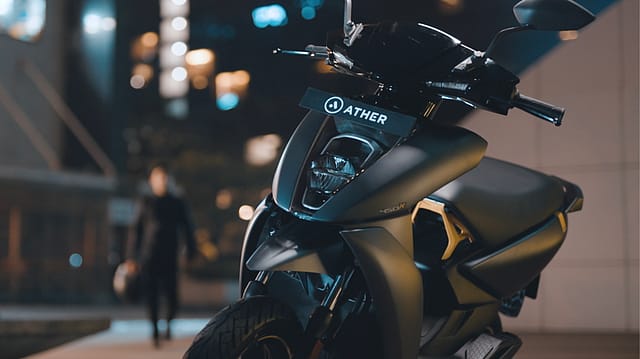Hero MotoCorp invests additional ₹124 crore in Ather Energy
ADVERTISEMENT

Hero MotoCorp has pumped an additional ₹124 crore in electric scooter maker Ather Energy. India's largest two-wheeler manufacturer previously owned 39.7% stake in the startup.
The investment is being made in the form of purchase of additional shares from an existing shareholder of Ather Energy for acquisition of up to 2.2% shares, Hero MotoCorp says in a regulatory filing.
Ather Energy, India’s fourth largest electric scooter maker, clocked 6,045 vehicle registrations in May, up 47% compared with 4,117 over the previous month. The EV startup launched its much awaited family scooter, the Rizta in April.
Hero MotoCorop, which retails e-scooters under its Vida brand, sold 2,456 electric two-wheelers in May as against 955 units in April.
E2W registrations hit a low of 65,111 in April from a high of 1,39,531 in March before the subsidy amount was slashed under the new ₹500-crore Electric Mobility Promotion Scheme (EMPS) scheme. The Faster Adoption and Manufacturing of Electric Vehicles (FAME-II) scheme expired in March this year, leading to a spike in sales in March as customers rushed to buy E2Ws at cheaper prices.
December 2025
The annual Fortune 500 India list, the definitive compendium of corporate performance, is out. This year, the cumulative revenue of the Fortune 500 India companies has breached $2 trillion for the first time. Plus, find out which are the Best B-schools in India.
Under the new scheme, which will run for four months till July 31, 2024, the government has lowered the maximum subsidy cap on e2W to ₹10,000 per vehicle from ₹22,500 earlier.
Ola Electric, the country’s largest electric scooter maker, clocked 37,225 registrations in May, a 9% rise over the previous month when incentives were slashed to ₹10,000 per vehicle, as per Vahan data. Ola retailed 53,522 e-scooters in March 2024 ahead of the expiry of the FAME-II scheme.
TVS Motor Company, India’s second-largest electric two-wheeler maker, recorded 11,790 EV registrations in May, a 52% jump over the previous month when it retailed 7,742 EVs. Bajaj Auto retailed 9,214 electric scooters in May compared with 7,555 in April.
In May, Hero MotoCorp said it will take big strides in electric vehicles through product launches in the mid and affordable segments in the coming year. The automaker expanded its emerging mobility brand, Vida, to 100 cities in the country.
But range anxiety is still an impediment in India’s transition from ICE (internal combustion engine) to electric vehicles.
To solve this, Ather Energy has set up India’s largest two-wheeler fast charging network with over 2,000 chargers spread across 100 cities.
Ather opened its charging connector patents to other OEMs in August 2021. A year later, Hero MotoCorp, which owns a significant stake in the startup, became the first OEM to use its connector.
"There are at least 5-6 more OEMs who are on the way to adopting it. Their design teams are working with ours to finish testing," Ather co-founder and CEO Tarun Mehta told Fortune India last year. “Our charging network is a big carrot for a lot of start-ups. Once you see some companies come on board, the other three large OEMs will also flip. That’s pretty much what the national standard is,” Mehta said.
Ather's locally-developed combined charging standard for light electric vehicles has also been recognised by the Bureau of Indian Standards (BIS). Ola Electric has its own proprietary chargers, making its fast-charging Hypercharger network unusable for other EVs.
The EV adoption would be faster if the government could insist on using just one standard but it is a little difficult to do this at this stage, Mehta had said.
Echoing similar views, Anshul Gupta, managing director of Okaya EV, told Fortune India recently that a uniform standard is needed otherwise everybody is going to burn money by setting up different networks or the government has to invest in two particular technologies using the taxpayers' money. “The infrastructure will not be ustilised if only a few people are able to use it,” he said.
